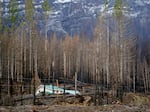How should Oregon determine which parts of the state face the highest wildfire risk? A new set of rules will guide a statewide process of identifying high fire risk areas and mapping the level of risk on every single tax lot.
The Oregon Department of Forestry is holding three virtual public meetings this week to take comments on the rules before they’re used to build a map intended to classify the wildfire risk on properties across the state as being at extreme, high, moderate, low or no risk.
The resulting wildfire risk map could have major consequences for property owners and developers because the state is also crafting new building codes and zoning requirements to protect homes in high fire risk areas from burning.

Mary Bradshaw's fire-hardened home in Elkhorn, Oregon, on Feb. 26, 2021. It was one of few that survived the Beachie Creek fire in the area.
Kristyna Wentz-Graff / OPB
Derek Gasperini, a public affairs officer for ODF, said these draft rules outline how officials and scientists at Oregon State University will determine which properties face the most wildfire risk.
“And then there’s a lot of work that they have to do to produce a map that accomplishes what it’s supposed to accomplish,” he said. “We know people want to see the map. We want to see it too. But the map has to be based on the rules as we’re currently defining them.”
The mapping process includes identifying the residential areas near forests and wilderness that are known to face the highest risk of burning in wildfires. These areas are known as the wildland-urban interface or WUI.
The rules include a definition of the wildland-urban interface as an area where structures or other human developments meet or intermingle with wildlands or vegetative fuels. They also outline criteria for including tax lots in those areas such as the number of structures per acre and the amount of vegetation.
There are rules that define the appeal process for property owners who want to challenge the state’s wildfire risk classification of their tax lot as well as rules that detail what data will be used to build the wildfire risk map and update it over time.
The rulemaking process stems from a sweeping wildfire preparedness package Oregon lawmakers passed last year in response to the wildfires that burned about 4,000 homes and more than a million acres in the state in 2020.
The rulemaking process has sparked controversy, particularly as it relates to parts of the bill that directly affect property owners, such as requirements to clear flammable trees and brush around homes, as well as mandates that new homes use fire-resistant “home hardening” measures and less-flammable materials.
“There are opposing views,” Gasperini said. “There are those that want a very small WUI because folks don’t want to be subject to regulation whatever that might look like. There are also folks who do want to be in the WUI because there are grants available to help people pay for home hardening requirements.”
Tax lots within the wildland-urban interface that are labeled as high or extreme wildfire risk in the mapping process will be subject to additional requirements for reducing wildfire risk under the new law.
ODF estimates about 900,000 tax lots may be within the wildland-urban interface, and about 230,000 of those tax lots may be classified as being at extreme or high risk of wildfire.
The Oregon State Fire Marshal and the Oregon Department of Consumer and Business Services are developing new rules for clearing defensible space around homes and applying wildfire hazard building code standards. The wildfire risk map will help determine where the new rules will apply.
The Board of Forestry approved the draft rules for release to the public. After receiving public comment, the board is scheduled to vote on the final rules in June.
The state has until June 30 to develop a wildfire risk map and alert property owners in extreme or high fire risk areas.
The public can comment on the new rules at virtual meetings scheduled for 9 am Tuesday, 2 pm Wednesday and 7 pm Thursday. People can also email comments to sb762.rulemaking@oregon.gov until 5 pm May 2.

